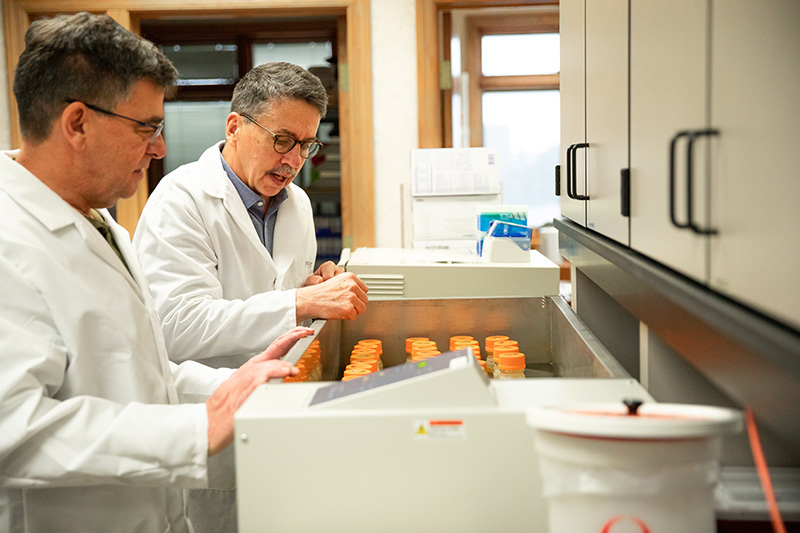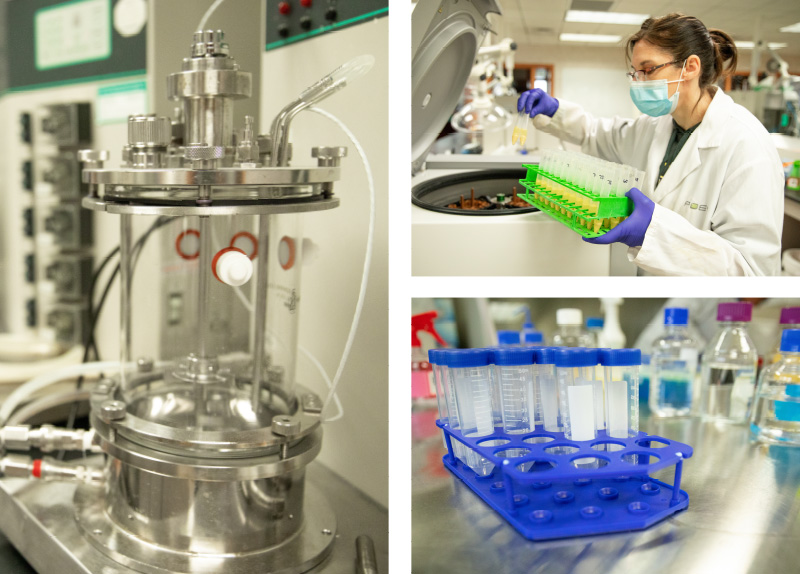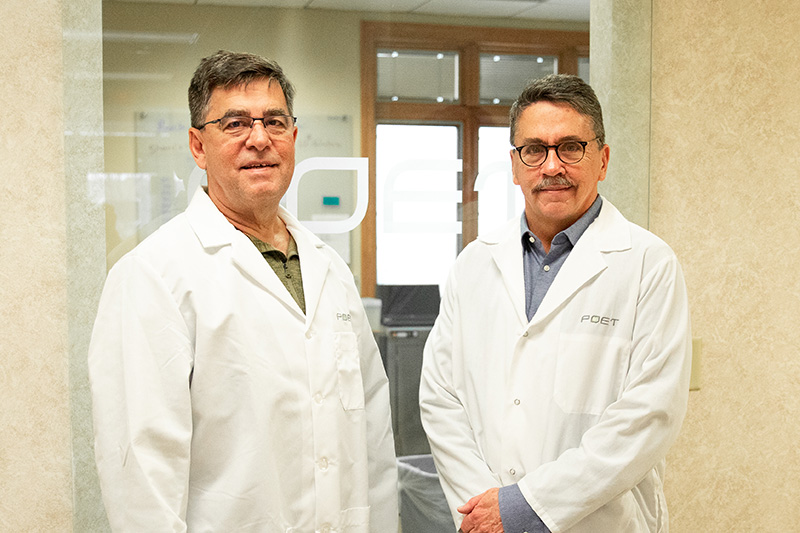Sioux Falls isn’t widely recognized as a hub of innovation like Palo Alto. It doesn’t have the buzz of North Carolina’s Research Triangle.
But when it comes to biotechnology research and development, South Dakota is no longer flyover country.
“We’ve got as much innovation going on here as many of those big tech areas,” said Steve Lewis, POET Vice President of Innovation.
Dave Bushong and Steve Lewis work in the POET lab
The once bucolic farming communities where POET operates are booming with innovative ideas and the people who can turn them into reality.
For more than 34 years, POET’s mission has centered on developing technologies to efficiently produce sustainable biofuels and oil alternatives to clean the air and reverse the dangerous impacts of climate change.
A big part of this involves an intellectual property strategy to manage trade secrets, copyrights, trademarks and patents. The work has paid off, with more than 150 active U.S. patents and applications and another 150 active foreign patents and applications.
“Bioethanol is a commodity product, and POET produces the same bioethanol as its competitors,” said Dave Bushong, POET Senior Vice President of Research. “We wanted to have the most competitive plants and processes out there. We wanted to be a leader for efficiency and overall plant performance. We needed a way to differentiate ourselves.”
POET invested in research and development early on. As the biofuels industry grew, it became more typical for other bioethanol companies to think about research and development, too, Bushong said. Many companies contract with outside researchers, but POET’s R&D has always been homegrown.
“POET’s always fostered that spirit of innovation from within. Innovation is just part of our DNA.”
Dave Bushong, POET Senior Vice President of Research
That culture of innovation is what led to POET’s first family of patents: the no-cook BPX® process.
In traditional corn-to-bioethanol production, the corn is ground, mixed with water and then heated in a jet cooker. The resulting material is liquefied and used in a fermentation process, where the starches are converted to sugars and the sugars to alcohol.
POET researchers wanted to optimize the process.
They were first successful in bringing up the gravity, or increasing the solids, in their conventional production process. As researchers increased the solids, they discovered that the levels of residual starch in the leftovers of fermentation increased. The POET researchers began looking into ways to convert these leftover starches into sugars, and ultimately bioethanol, by running tests using raw starch flour and various enzymes. They eventually discovered a side activity in the enzymes that achieved raw starch hydrolysis, the conversion of starches to fermentable sugars, without the cooking and liquefaction steps present in the traditional method.
The POET Research lab
“This was the serendipitous event,” Lewis said. “We discovered that, with a few changes here, we can actually convert raw starch to bioethanol in a very efficient manner.”
In order to talk about the project with a degree of confidentiality, the new avenue of research was given the code name “Broin Project X,” or BPX.
Attempts to optimize the conventional process continued in concert with research into the new raw starch method, but the focus of the company’s efforts soon shifted.
“At some point, we realized that the raw starch process was out-competing the conventional one,” Lewis said. “We were saving in energy, and we had higher yields. It was altogether a much more efficient process. Initially, the raw starch process was just an intellectual curiosity. But as we learned more about its specific advantages, it transitioned from an interesting discovery to an exciting commercial opportunity.
While much of POET’s research focuses on improving processes for its core bioproduct, like the BPX patent, it’s also about looking for opportunities to expand its bioproduct line.
The family of patents related to extracting Voilà corn oil is a prime example. Extracting the corn oil provides an additional bioproduct stream that can be utilized in multiple markets, including biodiesel and renewable diesel production, mixing into animal feed to improve fat content and even as an additive to recycled asphalt as a natural rejuvenator, Lewis said.
“In the past, this oil would go out with animal feed. Now we’re able to separate the oil during the process and sell it separately. This is important to POET and the industry,” Lewis said.
Other patents focus on the work POET is doing to decrease the company’s environmental footprint.
The patent related to the Combustion of High Solids Liquid provides a recycled fuel source to help manage energy use at locations with a solid fuel boiler. This source uses syrup, an energy-containing co-product, as an energy source for the biorefinery and creates a local, sustainable energy source.
The Dual Tank Heat Transfer patent was designed to help recover heat loss during condensing of vapors. By capturing this heat and recycling it into the system, less energy is required to run the process, helping to decrease costs and decrease the environmental impacts of energy production.
And the Total Water Recovery patents allow for the reduction of water brought into the biorefinery while also recycling water back into the system to prevent the release of excess wastewater.
“Commercial successes are important, and it’s fun to see the technology work. But it’s most satisfying when you can take a product to the marketplace that improves the environment, improves our standard of living and improves the business.”
Dave Bushong, POET Senior Vice President of Research
Though most of POET’s patents stem from the core research team, innovative ideas can come from anywhere. “That’s one of POET’s core values,” Bushong said. “We really respect and appreciate that.”
A great example is the “Load Toad” patent. The Load Toad was developed to improve the process of loading railcars with dried distiller’s grains. By allowing for a more consistent flow of the DDGS, the material is distributed more evenly in the railcars, allowing them to be shipped fuller.
“What’s really interesting about innovation is when we discover something and wonder why we didn’t think of that earlier,” Lewis said. “It seems obvious in hindsight, but it’s really novel and unforeseen.”
Not everything will be a commercial success or be a fit for the marketplace, Bushong admits. “That’s research, and that’s business,” he said. “Not everything we do works, even though that’s personally painful for me to have to admit.”
But that’s just part of the process.
“Each day, we find new ways to build a better world for future generations,” Lewis said. “We’re just getting started.”









